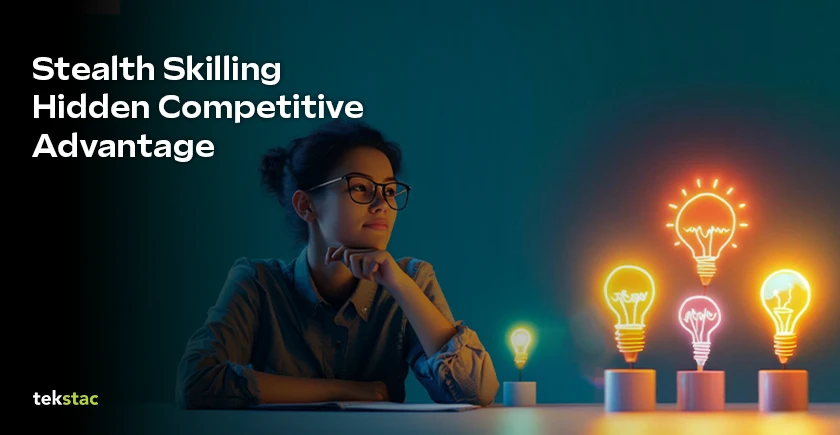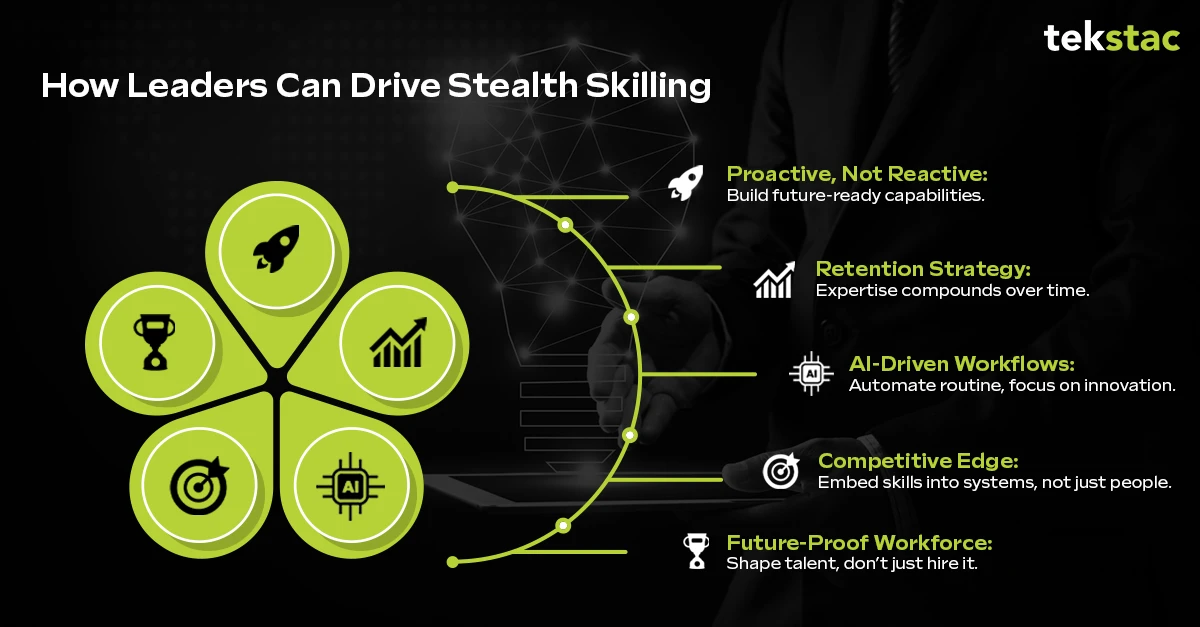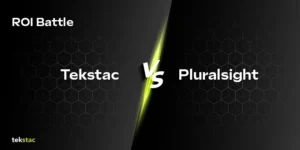Stealth Skilling: Build Future-Ready Enterprise Capabilities

What Is Stealth Skilling and Why It Matters
Imagine walking into a room full of leaders, all discussing their generative AI strategies. Certifications, courses, and training programs dominate the conversation, and every organization is racing to close skills gaps. Yet, one company is silent, confident, and observably ahead—its capabilities are evident in its results, but the source of its success remains invisible.
What’s their secret? Stealth skilling: a deliberate strategy to build capabilities competitors can’t replicate or even detect until it’s too late.
In the generative AI era, the most critical skills aren’t taught in public classrooms or certification programs. They’re embedded deep into workflows, codified into systems, and honed silently in the shadows of innovation. For companies that understand this, the focus has shifted from reacting to today’s needs to creating future-proof capabilities. They’re not playing to catch up—they’re designing capabilities that will leave their competitors irrelevant.
From Gaps to Mastery: The Stealth Skilling Revolution
The traditional approach to workforce skilling is broken. Companies identify a gap, train their workforce, and deploy talent to fill it. But this endless cycle of identifying and closing gaps creates a perpetual lag. By the time a workforce catches up, the industry has already moved on.
1. How Stealth Skilling Flips the Paradigm
Stealth skilling flips this paradigm. It’s not about filling gaps; it’s about predicting and embedding future capabilities before they’re even needed. In 2024, while 75% of companies are adopting AI, only 35% of talent have received AI training in the last year (Randstad, 2024). This gap highlights why reactive training alone isn’t enough—organizations need a stealth approach to build future-ready capabilities.
Organizations at the forefront of this revolution are rethinking how knowledge is captured, applied, and scaled. For example, rather than training teams on reactive problem-solving, they’re automating expertise into systems that anticipate issues before they arise. This isn’t just operational efficiency; it’s strategic foresight.
2. Knowledge Management as the Cornerstone of Stealth Skilling
Take knowledge management as a cornerstone. In most companies, expertise is siloed, locked away in the minds of employees or scattered across disconnected systems. Stealth skilling demands a different approach: codify that expertise into AI systems so that it becomes institutional knowledge, always accessible and never lost. For a CXO, this means no more scrambling to replace expertise when key employees leave or retire. Instead, the knowledge evolves within AI systems, continuously refining itself.
Stealth Skilling: Building an Invisible Competitive Moat
The true strength of stealth skilling lies in its invisibility. These capabilities aren’t broadcasted in glossy training catalogues or LinkedIn updates. Instead, they manifest in quiet but transformative outcomes: faster decision-making, predictive insights, and processes that adapt autonomously to market changes. Competitors don’t see it happening until they’re already left behind.
Picture a company that embeds real-time signal detection into its decision-making workflows. While others are still analyzing lagging indicators, this company adjusts in real-time to weak market signals, capitalizing on opportunities or mitigating risks before anyone else notices. These capabilities are the result of deliberate, behind-the-scenes skilling investments—not in employees alone but in building the AI systems that augment them.
Unlike traditional skilling programs, stealth skilling isn’t about incremental improvements. It’s about creating a gap so wide that competitors can’t bridge it. By the time rivals notice, the playing field has already tilted irreversibly.
How CXOs Can Implement Stealth Skilling Successfully
Stealth skilling doesn’t just happen. It requires a mindset shift from leaders, particularly at the CXO level. The first step is recognizing that today’s most valuable capabilities aren’t reactive—they’re proactive. Leaders must identify processes critical to long-term differentiation and begin embedding expertise into systems, not just people.

The focus should also extend to retention. Employees equipped with future-ready capabilities feel more engaged and aligned with the company’s vision. Retention isn’t just about reducing churn—it’s about building an ecosystem where expertise compounds over time, creating lasting competitive advantages. Moreover, as the war for talent intensifies, this approach signals to the market that your organization isn’t just hiring for today but shaping the workforce of tomorrow.
Operationally, this translates into investing in knowledge capture systems that scale expertise across teams. For instance, workflows that previously relied on manual judgment can be enhanced with AI-driven decision layers. The result? Teams can focus on innovation, while routine tasks are handled autonomously.
Why Stealth Skilling Is the Key to Future Competitive Advantage
In the world of generative AI, where visible strategies are quickly commoditized, stealth skilling is the competitive moat that can’t be breached. It ensures not just survival but dominance. By embedding expertise into AI systems, predicting skill needs before they arise, and continuously refining capabilities, organizations can stay ahead of market shifts and competitor plays.
For CXOs, the question isn’t whether to invest in stealth skilling—it’s how quickly they can implement it before others do. This is the difference between leading the AI race and being left behind in a game you never even realized was happening.
TL;DR:
Stealth Skilling embeds invisible, future-ready capabilities into workflows and AI systems, creating a competitive advantage that rivals can’t replicate. Organizations that implement it proactively stay ahead in the generative AI era.
FAQs on Stealth Skilling
1. How is stealth skilling different from traditional training?
Traditional training fills current skill gaps; stealth skilling predicts and builds capabilities proactively.
2. Why is stealth skilling important for enterprises?
It creates a competitive moat that is hard to replicate, enabling faster decisions and future-proof operations.
3. Who should lead stealth skilling initiatives?
CXOs and senior leaders should drive the strategy, embedding expertise into systems and aligning the workforce for long-term advantage.
4. What is a stealth strategy?
A stealth strategy is a business approach where initiatives, capabilities, or innovations are developed quietly to gain competitive advantage before others notice.





